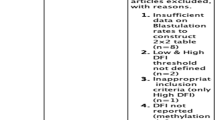Abstract
Purpose: Despite advances in assisted reproduction, there is no progress in quality control bioassays. The objectives were to develop a comet assay to measure DNA fragmentation in thawed cryopreserved oocytes and compare this assay with one-cell mouse embryo bioassay.
Methods: Thawed hamster oocytes from a commercial source were incubated in culture media with either 0-, 50-, or 100-μM hydrogen peroxide, or, in media exposed to different contact materials and unknown proficiency analytes. Incubation time was 1.5 h at 37°C. The oocytes were dried, fixed, stained with acridine orange, embedded in a mini-agarose layer and electrophoresis was carried out. Fluorescent images were analyzed. The results were compared with standard one-cell mouse assay data.
Results: The 100-μM hydrogen peroxide treatment caused greatest DNA fragmentation in the hamster oocytes at Hours 1 and 2. A dose response was observed. Intrassay coefficient of variation was 5.7%. Only one of the five materials tested passed both assays. The data for the unknown proficiency analytes were similar for both assays.
Conclusions: The oocyte comet assay demonstrated DNA fragmentation in the presence of toxic substances. The detection of toxicity in two materials that passed the mouse bioassay suggested increased sensitivity in the new assay. The oocyte comet assay and the mouse bioassay results matched in the proficiency test. However, more studies are still needed to determine optimal sensitivity.
Similar content being viewed by others
REFERENCES
Ackerman SB, Swanson RJ, Stokes GK, Veeck LL: Culture of mouse preimplantation embryos as a quality control assay for human in vitro fertilization. Gamete Res 1984;9:145-152
Condon-Mahoney M, Wortham JWE Jr, Bundren JC, Witmyer J, Shirley B: Evaluation of human fetal cord sera, Ham's F-10 medium, and in vitro culture materials with a mouse in vivo fertilization system. Fertil Steril 1985;44:521-525
Fukuda A, Noda Y, Tsukui S, Matsumoto H, Yano J, Mori T: Influences of water quality on in vitro fertilization and embryo development for the mouse. J Vitro Fert Embryo Transf 1987;4:40-45
Parinaud J, Reme J, Monrozies X, Favrin S, Sarramon M, Pontonnier G: Mouse system quality control is necessary before the use of new material for in vitro fertilization and embryo transfer. J Vitro Fert Embryo Transf 1987;4:56-58
Davidson A, Vremiseh M, Lobo RA, Paulson RJ: Mouse embryo culture as quality control for human in vitro fertilization: the one-cell versus two-cell model. Fertil Steril 1988;49:516-521
Rinehart JS, Bavister BD, Gerrity M: Quality control in the in vitro fertilization laboratory: comparison of bioassay systems for water quality. J Vitro Fert Embryo Transf 1988;5:335-342
Gorrill MJ, Rinehart JS, Tamhane AC, Gerrity M: Comparison of the hamster sperm motility assay to the mouse one-cell and two-cell bioassays as quality control tests for in vitro fertilization. Fertil Steril 1991;55:345-354
Johnson DE, Hodgen GD:Syringe-associated toxicity of culture media on mouse and monkey preembryos. J Vitro Fert Embryo Transf 1991;8:198-201
Bavister BD, Andrews JC: A rapid sperm motility bioassay procedure for quality-control testing of water and culture media. J Vitro Fert Embryo Transf 1988;5:67-75
Stewart-Savage J, Bavister BD: Deterioration of stored culture media as monitored by a sperm motility bioassay. J Vitro Fert Embryo Transf 1988;5:76-80
Purdy JM: Methods for fertilization and embryo culture in vitro. In Human Conception In Vitro RG Edwards, JM Purdy (eds), London, Academic Press, 1982, pp. 135-148
Critchlow JD, Matson PL, Newman MC, Horne G, Troup SA, Lieberman BA: Quality control in an in-vitro fertilization laboratory: Use of human sperm survival studies. Hum Reprod 1989;4:545-549
Bertheussen K, Holst N, Fosdahl F, Høie KE: A new cell culture assay for quality control in IVF. Hum Reprod 1989;4:531-535
Fleming TP, Pratt HP, Braude PR: The use of mouse preimplantation embryos for quality control of culture reagents in human in vitro fertilization programs: A cautionary note. Fertil Steril 1987;47:858-860
Silverman IH, Cook CL, Sanfilippo JS, Yussman MA, Schultz GS, Hilton FK: Ham's F-10 constituted with tap water supports mouse conceptus development in vitro. J Vitro Fert Embryo Transf 1987;4:185-187
Östling O, Johanson KJ: Microelectrophoretic study of radiation-induced DNA damages in individual cells. Biochem Biophys Res Commun 1984;123:291-298
Singh NP, McCoy MT, Tice RR, Schneider EL: A simple technique for quantitation of low levels of DNA damage in individual cells. Exp Cell Res 1988;175:184-191
Singh NP, Danner DB, Tice RR, McCoy MT, Collins GD, Schneider EL: Abundant alkali sensitive sites in DNA of human and mouse sperm. Exp Cell Res 1989;184:461-470
Kent CR, Eady JJ, Ross GM, Steel GG: The comet moment as a measure of DNA damage in the comet assay. Int J Radiat Biol 1995;67:655-660
Klaude M, Ericksson S, Nygren J, Ahnström G: The comet assay: Mechanisms and technical considerations. Mutat Res 1996;363:89-96
Rafferty KA Jr.: Superovulation and phasing of ovulation. In Methods in Experimental Embryology of the Mouse, KA Rafferty Jr. (eds), Baltimore, The John Hopkins Press, 1970, pp. 23-29
Fairbairn DW, Olive PL, O'Neill KL: The comet assay: A comprehensive review. Mutat Res 1995;339:37-59
McKelvey-Martin VJ, Green MHL, Schmezer P, Pool-Zobel BL, De Meo MP, Collins A: The single cell gel electrophoresis assay (comet assay): A European review. Mutat Res 1993;288:47-63
Hughes CM, Lewis SE, McKelvey-Martin VJ, Thompson W: A comparison of baseline and induced DNA damage in human spermatozoa from fertile and infertile men, using a modified comet assay. Mol Hum Reprod 1996;2:613-619
Author information
Authors and Affiliations
Rights and permissions
About this article
Cite this article
Chan, P.J., Calinisan, J.H., Corselli, J.U. et al. CLINICAL ASSISTED REPRODUCTION: Updating Quality Control Assays in the Assisted Reproductive Technologies Laboratory with a Cryopreserved Hamster Oocyte DNA Cytogenotoxic Assay. J Assist Reprod Genet 18, 129–134 (2001). https://doi.org/10.1023/A:1009472323011
Issue Date:
DOI: https://doi.org/10.1023/A:1009472323011




